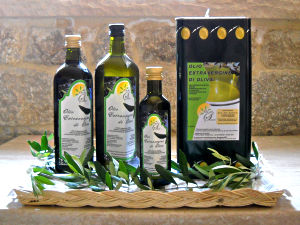


Extra Virgin Olive Oil
Sannio Yellow Gold
The extra-virgin olive oil "Sannio Yellow Gold" is produced in the high hills (650 m above sea level) on 450 plants of Ortice variety (historic Sannio cultivar) 30%, Leccino 50%, other historical variety 20%, above an area reported in cadastre to the sheet 22, particles 62, 73,78, 506 of Santa Croce del Sannio's district.

The product, certified organic, is obtained with the only organic fertilization and cover crop with legumes, without any parasitic treatment or fungicide which, however, there would be no need because the harsh and dry climate is unfavorable for pests (olive fly) and vegetable (sooty mold, insects).
The presence of polyphenols in quantity average of 221 mg / kg makes it a "medium fruity oil type" with variable organoleptic characteristics which depending on the prevalence, from year to year, of the olives' amount to one or the other variety, because it is an olive grove of more variety.
The company is associated with Arca Sannita, association that deals with research and preserve traditional cultivars in danger of extinction, in the field and horticultural fruit and preserve traditional processing techniques.
The extra virgin olive oil "Sannio Yellow Gold" is packaged in 500 ml bottles, 750 ml and 5 liter cans and is sold with a chemical analysis certificate that indicates acidity and the peroxide.
What is acid oil
Alfredo Marasciulo (Academy of the Georgofili)When we talk about very often extra-virgin olive oil is referenced to the acidity and in fact this parameter is probably the indicator that better than any other manages to synthesize an overall assessment on the chemical quality.
The acidity of an oil measuring the amount of fatty acids that are separated from the glycerol. Less fatty acids from the glycerol will be separated, it will be more integrates the molecule of the oil and consequently will lower its acidity. An extra virgin olive oil produced from healthy olives picked at the right level of maturity, using correct techniques of collecting, processing and preservation, will generally have a very low acidity.
Fermentative and oxidative phenomena are mainly responsible for the raising of the acidity as well as the onset of sensory defects. In other words, grind olives not healthy and not fresh or grind the olives incorrectly determines a separation of glycerol from fatty acids, an oil acidity rise and the onset of organoleptic defects or of unpleasant odors and flavors.
The acidity of an oil is the expression of something that the human organism is not able to assess with their own senses.
It is therefore important to emphasize that no one, not even an expert taster, will determine the acidity of an oil tasting it, but to know it will have to resort to chemical analysis.
By law, to be classified as "extra virgin" olive oil must have an acidity less than 0.8%.
What does the number of peroxides
The peroxide is a chemical parameter that indicates the state of conservation of the oil, in fact, it measures the amount of oxygen that was absorbed by the oil. And it expressed in mill equivalents of active oxygen per kilogram, which oxidize potassium iodide. The aging processes, in fact, lead to progressive oxidation of the oil, with increasing formation of peroxides, which are chemical species, derived from the oxidation of the unsaturated fatty oil. The reactions are triggered as aresult of the presence of initiators, peroxide substances, oxidative stress or by the action of enzymes (lip oxidase). The higher the peroxide number, the greater were the oxidative reactions which has gone to meet the oil.
For legislation an extra virgin oil must have a maximum amount of peroxides of 20 mEq / O2 / Kg. Extra virgin oils DOP <12 mEq / O2 / Kg. High quality extra virgin oils do not exceed 9.8 mEq / O2 / kg of peroxides.
Details
- the land registry references of the olive and the grinding mill are included on the label to ensure total traceability of the product, from where it is grown to where the milling is done.
- the collection takes place when the ripening is not yet complete (even if this results in a lower yield in oil) to ensure a low acidity.
- an extra virgin olive oil of excellent quality olive gives a sensation of "sting" in the throat, due to the presence of oleocantale, an anti-inflammatory substance that is said to have also anti-cancer effects.
- it is wrong, or the belief that olive oil is heavier and fat of other oils; actually not only the extra virgin olive oil has a very high digestibility but all types of oil are made up of 99% fat and thus their intake of calories is the same for everyone.
Oil quality certificates
Below we are published certificates of oil analysis attesting to its quality:
- Certificato dell'analisi dell'olio 2009.
- Certificato dell'analisi dell'olio 2010.
- Certificato dell'analisi dell'olio 2011.
- Certificato dell'analisi dell'olio 2012.
- Certificato dell'analisi dell'olio 2013.
- Certificato dell'analisi dell'olio 2014.
- Certificato dell'analisi dell'olio 2015.
- Certificato dell'analisi dell'olio 2016.
- Certificato dell'analisi dell'olio 2017.
- Certificato dell'analisi dell'olio 2018.
- Certificato dell'analisi dell'olio 2019.
- Certificato dell'analisi dell'olio 2020.
- Certificato dell'analisi dell'olio 2024.
Pagina Facebook
Impossibile visualizzare il plugin sociale della pagina aziendale su Facebook poiché si è scelto di disattivare il Plugin di incorporazione pagina di Pagine Facebook.
Per maggiori informazioni, visita la pagina Rivedi le tue scelte sui Cookie.
Condividi
Cookie di profilazione e/o di terze parti: bloccati

 Facebook
Facebook Twitter
Twitter Stampa
Stampa Per e-mail
Per e-mail